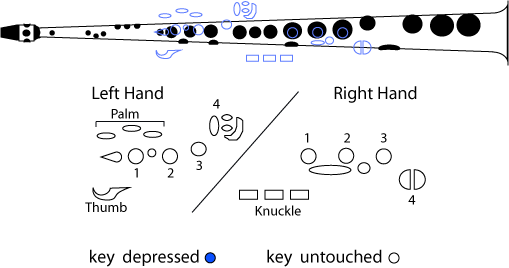How the saxophone measurements were made

| Acoustics of the saxophone |
How the saxophone measurements were made |
 |
A computer synthesises the signal and outputs it via an audio interface (Motu 828) to a power amplifier and loudspeaker. A horn matches the speaker to a waveguide (7.8 mm internal diameter) for delivery to the impedance head. The impedance head is mounted at a position near the tip of the reed in a fitting that seals to the mouthpiece, with no reed present. Measurements are made in a well-insulated room with low reverberation time. The effect of the reed is discussed below.
In the impedance head, three microphones are placed at positions along the waveguide. From the phase and amplitude differences among them, the reflection coefficient and thus the acoustic impedance is calculated.
Three reference impedances, none of them having a resonance, are used. One is a 'semi-infinite' cylindrical waveguide: a straight, stainless steel pipe of 7.8 mm internal diameter. Its impedance is therefore purely resistive. Its length of 142 m begins with a 40 m straight section, determined by the width of the Physics building. At 200 Hz, a tube of this diameter has an attenuation coefficient of 0.11 m-1 = -1.0 dB.m-1 [1] so the echo returns with immeasurable amplitude. Its impedance is therefore resistive, with resistance equal to its characteristic impedance, Rref = 8.5 MPa.s.m-3. Swagelok fittings are used to connect the elements. The 'semi-infinite' pipe is enclosed in a plastic pipe for sound insulation, and the plastic pipe is mounted above the bearers of the ceiling. The use of a frequency independent reference impedance improves the signal-to-noise ratio over the whole range, and means that the calibration does not depend upon theoretical assumptions about wall losses. Another calibration is an infinite impedance: ie a rigidly closed end. Another is a large flange. The system is described in more detail in the accompanying scientific paper [2].
The reed is an acoustical compliance which is, for the sake of this analysis, in parallel with the saxopohone [3]. A compliance is added algebraically. The values, expressed as that of a corresponding volume of air are 1.5 ml for the soprano and 3.25 ml for the tenor.
Because sound spectra depend very strongly on parameters determined by the player, by the radiation pattern of the saxophone, and by recording conditions, sound spectra recorded for human players can only be regarded as examples. The obtaining of examples typical of playing by a sax player under realistic, musically comfortable conditions are not consistent with obtaining exactly repeatable spectra. Sound spectra were measured using two microphones, one placed about 30 cm directly in front of the bell and the other at a distance of about 1 m directly in front of the player in a recording studio.
The player of both tenor and soprano saxophones is a distinguished professional, whose experience is primarily in jazz and contemporary music.

Figure 1. Fingering and acoustic schematic diagram for the saxophone.
|
Contact:
Joe Wolfe
/ J.Wolfe@unsw.edu.au |